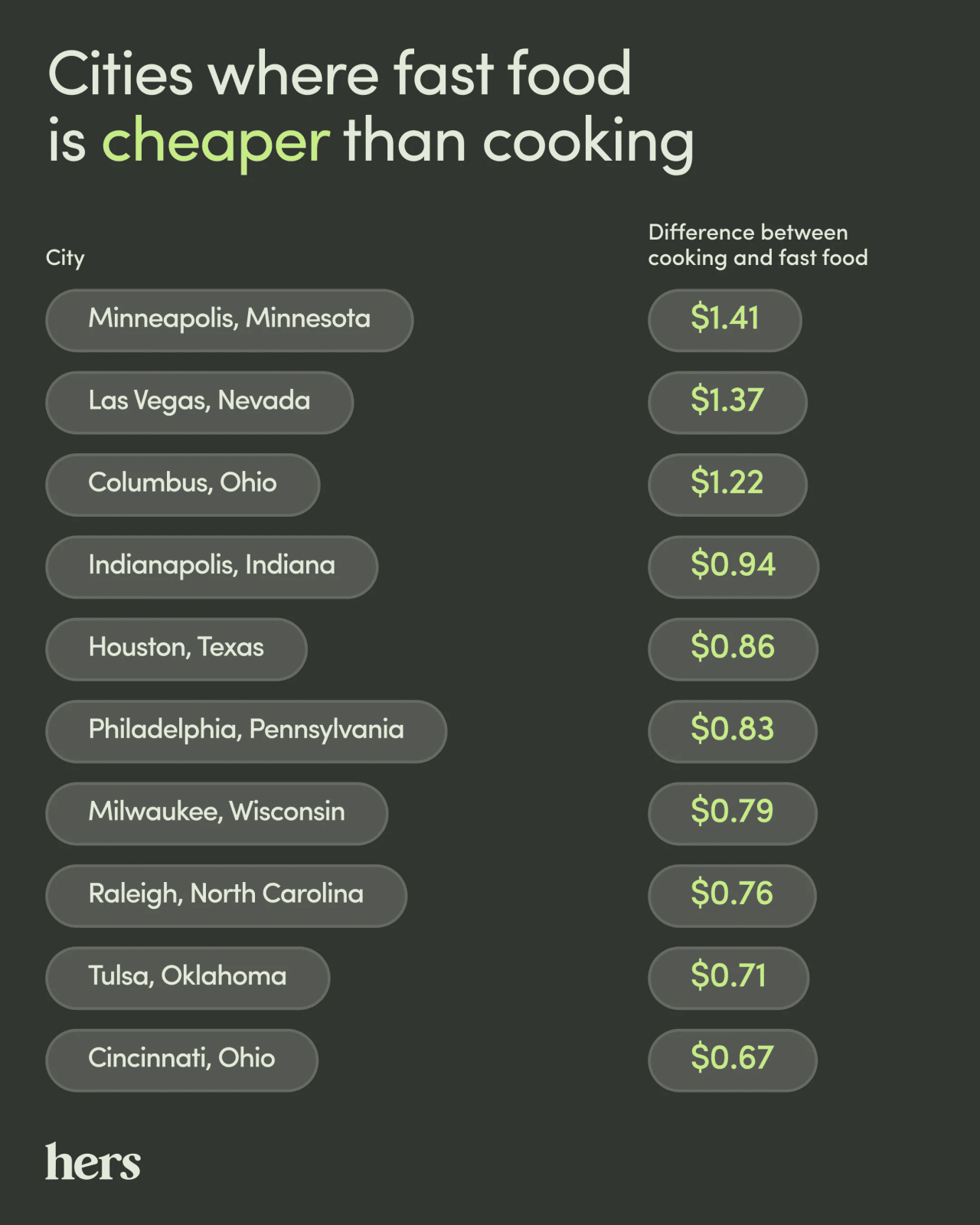Cities where fast food is cheaper than cooking
Lifestyle

Audio By Carbonatix
1:30 PM on Tuesday, October 21
By Olivia Rockeman for Hims, Stacker
Cities where fast food is cheaper than cooking
When your schedule is busy, getting fast food may seem like your most convenient option for eating a meal. But while eating out will generally save you time (compared to cooking), that takeout habit can be tough on your savings, right? According to recent data, not necessarily. In some places, in the battle of “fast food versus cooking,” takeout surprisingly reigns supreme for being both time-saving and wallet-friendly.
According to data from the Bureau of Labor Statistics, in the past five years, average grocery prices in the United States have risen by nearly 25%, and the rate of eating out has increased by about 30%. But these data points don’t offer a clear snapshot of whether eating out makes more sense than cooking — those averages neither consider price differences across cities nor weigh factors like nutritional value or the benefit of using extra groceries for various recipes throughout the week. Hims conducted a survey to clarify those data points.
This included an analysis of price data on grocery store ingredients and fast food meals from 50 metropolitan areas across the U.S. to help you determine whether — in your city — eating out is more or less expensive than cooking. To streamline this analysis, Hims calculated the cost of making one cheeseburger at home and compared it to the price of buying one at a fast food chain. In addition, Hims outlined the benefits of cooking at home, which are often overlooked when price is the only consideration.

The 29 Cities Where Getting Fast Food Is Cheaper Than Cooking, Ranked From the Largest To Smallest Price Difference
- Minneapolis, Minnesota ($1.41)
- Las Vegas, Nevada ($1.37)
- Columbus, Ohio ($1.22)
- Indianapolis, Indiana ($0.94)
- Houston, Texas ($0.86)
- Philadelphia, Pennsylvania ($0.83)
- Milwaukee, Wisconsin ($0.79)
- Raleigh, North Carolina ($0.76)
- Tulsa, Oklahoma ($0.71)
- Cincinnati, Ohio ($0.67)
- Dallas, Texas ($0.67)
- Austin, Texas ($0.56)
- Nashville, Tennessee ($0.54)
- Oklahoma City, Oklahoma ($0.52)
- Atlanta, Georgia ($0.50)
- Richmond, Virginia ($0.47)
- Salt Lake City, Utah ($0.45)
- Portland, Oregon ($0.40)
- Memphis, Tennessee ($0.37)
- New York, New York ($0.37)
- Detroit, Michigan ($0.34)
- Honolulu, Hawai‘i ($0.34)
- San Antonio, Texas ($0.32)
- Pittsburgh, Pennsylvania ($0.30)
- Kansas City, Missouri ($0.24)
- Chicago, Illinois ($0.16)
- San Jose, California ($0.11)
- Cleveland, Ohio ($0.09)
- Birmingham, Alabama ($0.03)
The 21 Cities Where Cooking at Home Is Cheaper Than Getting Fast Food, Ranked From Largest To Smallest Price Difference
- Buffalo, New York ($1.35)
- Jacksonville, Florida ($0.97)
- Los Angeles, California ($0.83)
- Sacramento, California ($0.82)
- San Diego, California ($0.78)
- Denver, Colorado ($0.76)
- Providence, Rhode Island ($0.60)
- Hartford, Connecticut ($0.57)
- Phoenix, Arizona ($0.55)
- Boston, Massachusetts ($0.45)
- Seattle, Washington ($0.43)
- San Francisco, California ($0.41)
- Washington, DC ($0.40)
- Tampa, Florida ($0.33)
- Baltimore, Maryland ($0.21)
- Rochester, New York ($0.21)
- St. Louis, Missouri ($0.10)
- Omaha, Nebraska ($0.10)
- Orlando, Florida ($0.09)
- Louisville, Kentucky ($0.08)
- Miami, Florida ($0.03)
Key Findings
- In Minneapolis, Las Vegas, and Columbus, making a burger at home is more than $1 pricier than it would be from a fast-food restaurant. While grocery prices in those cities don’t differ significantly from other places, the price of a fast-food burger was among the lowest of all the cities on our list.
- For major cities in Texas, on the other hand, getting fast food is cheaper than cooking. A recent report found that Texas is home to some of the cheapest fast food in the country, which helps explain our results.
- In major California cities, cooking at home is more affordable than getting takeout. Other than in San Jose, where the prices are about equivalent, it’s cheaper to make a cheeseburger at home. The West Coast’s rising labor costs, which are among the highest in the country, may help explain the discrepancy.
Fast Food vs. Cooking: Trends and Insights
Where is a fast food cheeseburger the most expensive?
- San Francisco, California ($7.36)
- Jacksonville, Florida ($7.01)
- San Diego, California ($6.93)
Where is a fast food cheeseburger the least expensive?
- Las Vegas, Nevada ($4.29)
- Minneapolis, Minnesota ($4.60)
- Houston, Texas ($4.72)
Where is the price of cooking a cheeseburger at home the most expensive?
- San Francisco, California ($6.95)
- New York, New York ($6.83)
- San Jose, California ($6.53)
Where is the price of cooking a cheeseburger at home the least expensive?
- San Antonio, Texas ($5.51)
- Dallas, Texas ($5.57)
- Austin, Texas ($5.57)
Methodology: How Hims Calculated Price Differences
Hims started by selecting the 50 largest U.S. metropolitan areas based on Census Bureau population data. To calculate the cost of cooking versus fast food in each region, Hims used the quarterly Cost of Living Index from The Council for Community and Economic Research (C2ER).
From this dataset, Hims pulled the price of a single fast food cheeseburger, along with prices for five ingredients required to make a burger at home: ground beef, lettuce, bread, cooking oil, and cheese. The calculations below were used to determine the cost of making just one burger, given that the data includes grocery items sold for more than one serving:
- One pound of ground beef totals four servings. Hims divided the price per pound by four.
- Grocery store loaves of bread typically include 20 slices, two of which are needed to make a burger. Hims divided the average price for a loaf of bread by 10.
- One head of iceberg lettuce is enough for four burgers. Hims divided the lettuce price by four.
- A 15-ounce bottle of cooking oil has about two servings per ounce. Hims divided the total price of a bottle by 30.
- The data contained an 8-ounce container of cheese, and a typical serving is two ounces. Hims divided the average price of cheese by four.
Hims then subtracted the price of a fast-food burger from the cost of cooking at home to determine which was more expensive. When the difference was positive, fast food was determined to be more affordable, and when the difference was negative, cooking was found to be cheaper.
Get the data here.
Four Major Benefits of Cooking at Home
While eating out can save time — and money, depending on where you live — cooking at home offers both nutritional and practical benefits that can make it worth prioritizing when possible. Here are some of those benefits:
- Better nutrition. Home-cooked meals allow you to control ingredients and preparation methods, such as which oil you use and how much salt you sprinkle into each dish. This helps reduce added sugars, sodium, and the unhealthy fats that are often found in restaurant meals. A 2017 study found that adults and adolescents substantially underestimate sodium content in restaurant meals, underscoring how difficult it is to detect what’s in restaurant dishes.
- Budget-friendly, particularly when taking meal-planning into account. While the one-for-one comparison in our research showed that fast food is sometimes cheaper than cooking, grocery shopping often results in leftovers you can incorporate into future meals. That means buying groceries goes further than a one-off fast-food meal. One study found home-cooked dinners to be associated with better compliance with dietary guidelines without requiring a significant bump in spending on food.
- Portion control for weight loss. Preparing meals at home allows you to manage portion sizes and overall calorie intake. Portion control can be an effective method for reducing weight, body mass index, and blood pressure.
- Long-term healthy habits. Cooking at home encourages mindful eating and consistent, predictable meal patterns. Spending more time in the kitchen and preparing healthy, tasty meals reduces the temptation of high-calorie fast food meals and supports weight management over time.
This story was produced by Hims and reviewed and distributed by Stacker.







